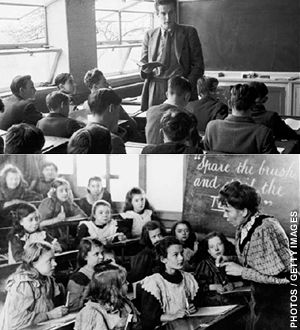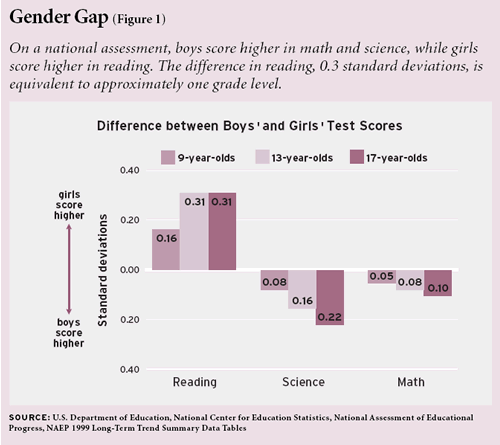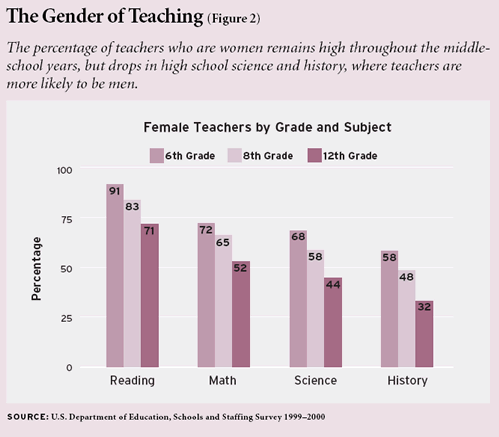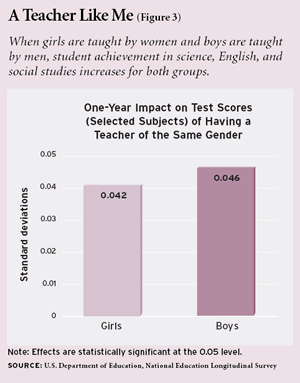
Gender gaps in educational outcomes are a matter of real and growing concern. We’ve known for a long time, since the 1970s, that girls outscore boys in the National Assessment of Educational Progress (NAEP) reading tests, while boys tend to outperform girls in math and science.
Boys are increasingly less likely than girls to attend college and to receive a bachelor’s degree. Meanwhile, female college students continue to be underrepresented in such technical fields as engineering and computer science.
One popular, if controversial, response to these patterns has been a renewed push for single-sex education—an effort that has drawn support from across political divides. An amendment to the No Child Left Behind Act authorizing the creation of single-sex public schools was sponsored by Republican senator Kay Bailey Hutchinson of Texas, but the measure passed in large part due to the support of Senator Hillary Clinton of New York, a Wellesley College graduate grateful for her opportunity to attend one of the country’s premier women’s colleges. (“Wellesley nurtured, challenged, and guided me,” she declared in her 1992 Commencement Day speech.) The National Association for Single-Sex Public Education reports that, as of April 2006, at least 223 public schools in the United States were offering gender-separate educational opportunities, up from just 4 in 1998. Although most were coeducational schools with single-sex classrooms, 44 were wholly single-sex.
The majority of arguments for single-sex schools and classrooms focus on the effects on interactions among students, but they also present the possibility of greatly increasing the number of students with teachers of the same gender. Is there any convincing evidence that doing so could make a difference in education—for boys and girls alike? So far the jury has been out, but my analysis of national survey and test-score data collected by the U.S. Department of Education (DOE) allows me to offer new and convincing evidence of the differential impact of a teacher’s gender on student learning.
The Gender Gap
The evolution of the gender gaps in achievement as children mature suggests that what occurs in schools and classrooms may play an important role. According to the Department of Education’s Early Childhood Longitudinal Study, when children enter kindergarten, the two genders perform similarly on tests of both reading and mathematics. But a few years later, by the spring of the 3rd grade, boys, on average, outperform girls in math and science, while the girls outperform the boys in reading. Disconcertingly, NAEP results show that for children between the ages of 9 and 13, the gender gaps in science and reading roughly double and the math gap increases by two-thirds. For children between the ages of 13 and 17, there is modest growth in the math and reading gender gaps but a substantial expansion of the gap in science (see Figure 1).

The gender gaps in achievement as students finish high school are far from trivial. In reading, 17-year-old boys score 31 percent of a standard deviation below 17-year-old girls, a deficit equal to about one grade level. This is nearly half the size of the black-white test-score gap in reading. In science and math, meanwhile, girls of that age score 22 percent and 10 percent of a standard deviation lower, respectively, also a difference worthy of concern.
Drowned out by the din of public argument over the role of nature vs. nurture is a debate, far from settled, over exactly how the experience of going to school shapes learning among boys and girls. One school of thought contends that teachers, both men and women, treat boys and girls differently in the classroom. For example, some controversial evidence, based on classroom observations, suggests that both are likely to offer praise and remediation in response to comments by boys but mere acknowledgment to comments by girls. Some cognitive scientists suggest that teachers may subtly communicate different academic expectations of boys and girls and these biased expectations may become self-fulfilling.
Teacher Gender Matters
Other theories, of special interest here, suggest that much depends on the gender of the teacher. One theory asserts that the teacher’s gender shapes communications between teacher and pupil, while another says the teacher acts as a gender-specific role model, regardless of what he or she says or does. According to this second theory, students are more engaged, behave more appropriately, and perform at a higher level when taught by one who shares their gender.
Tests of these theories have relied primarily on information about teachers and students in college and graduate school. Findings have been mixed, so the issue remains unresolved. Studies have not focused on young adolescents, the time when students are particularly sensitive to gender differences and when gender gaps in achievement are pronounced.
I investigated the effect of a teacher’s gender using the National Education Longitudinal Survey (NELS), which contains data on a nationally representative sample of nearly 25,000 8th graders from 1988. In addition to examining the effect of teacher gender on students’ test-score performance, I examined teacher perceptions of a student’s performance and student perceptions of the subject taught by a particular teacher. I was especially interested in the influence of a teacher’s gender on students’ perceptions, because engagement with an academic subject may be an important precursor to subsequent achievement levels, course selection in high school and college, and also occupational choice. For example, the underrepresentation of women in fields like engineering and computer science may be due to levels of confidence and interest in related subjects in high school.
Indeed, my results confirm that a teacher’s gender does have large effects on student test performance, teacher perceptions of students, and students’ engagement with academic material. Simply put, girls have better educational outcomes when taught by women and boys are better off when taught by men. These findings persist, even after I account for a variety of other characteristics of students, teachers, and classrooms that may influence student learning. They are especially important for young men when one considers that the percentage of 6th-grade teachers who were female ranged from 58 to 91 percent across four core subjects (math, science, reading, and history). Although these percentages decline in later grades, 83 percent of the English teachers in 8th grade are female, as are more than half of 8th-grade math and science teachers (see Figure 2).

A Mother Lode of Gender Data
Key to my findings is the National Education Longitudinal Survey, initiated in 1988 as a survey of a nationally representative sample of 8th-grade students from 1,052 public and private schools. The DOE resurveyed a sample of these students during four follow-up reviews, in 1990, 1992, 1994, and 2000. For my study I rely only on the NELS data from 1988, which is based on surveys of 24,599 students and two of each student’s teachers.
In particular, I exploit a unique feature of the teacher surveys. For each sampled student, NELS administered questionnaires to teachers from two academic subjects: mathematics and English; mathematics and history; science and English; and science and history. Two completed teacher surveys are available for 21,324 of the 8th-grade students—a bit smaller than the full sample of NELS students because some teachers did not complete their questionnaires and some students did not have a class in one or both of the academic subjects randomly assigned to their school for which teacher surveys were administered.
The teacher survey solicited a variety of information about the teacher’s background, including gender. It also included several questions about how the teacher viewed the behavior and performance of the specific students in the study. I was most interested in the effect of gender on three assessments that appear to be particularly good indicators of academic development. Teachers were asked to simply respond yes or no as to whether the student was frequently disruptive, consistently inattentive, or rarely completed homework.
The student component of NELS includes additional outcome data for the subjects taught by each sampled teacher, including the results from multiple-choice achievement tests. The survey also asked students questions about their engagement with the subject. In particular, students indicated whether they were afraid to ask questions in that subject, looked forward to their class, and saw the subject as useful for their future. NELS also solicited information about each student’s gender as well as a variety of other demographic and socioeconomic characteristics.
NELS is a goldmine of information for those interested in gender dynamics within the classroom. Especially noteworthy is the fact that data are available from the same student in two different subjects taken from two different teachers, which enables us to account for educationally relevant characteristics of students that cannot be ascertained by conventional background characteristics. In other words, these “matched-pairs” data allow us to see how the outcomes of the same student vary with two different teachers.
When estimating the effect of a teacher’s gender, I use standard statistical techniques to adjust for the effect of several other teacher and classroom characteristics that may affect student outcomes. For example, I take into account whether the student shares the teacher’s race and ethnicity, because some of my own prior research suggests that the race of a teacher may influence student outcomes (see “The Race Connection,” Education Next, Spring 2004). I also consider the size of the class, the percentage of students in the classroom with limited English proficiency, the number of years a teacher has been working in the profession, and whether the teacher is state-certified in the subject he or she is teaching. What does this valuable set of data reveal about the connections between gender and learning?
The Most Important Findings
For three subject areas—science, social studies, and English—the overall effect of having a woman teacher instead of a man raises the achievement of girls by 4 percent of a standard deviation and lowers the achievement of boys by roughly the same amount, producing an overall gender gap of 8 percent of a standard deviation, no small matter if it can be assumed that this happened over the course of a single year. In fact, these estimates suggest that the effects of a year with a teacher of a particular gender are quite large relative to the gender gaps in achievement in the national datasets mentioned above. But I am hesitant to draw that conclusion in the absence of information about the gender of the teacher the student had in preceding years. Some of what I attribute to the 8th grade might have occurred in previous years, if the student had had multiple years of schooling from a teacher of the same gender.
While these results summarize the overall impact of teacher’s gender on test scores, the effects vary somewhat from one subject to the next. Test-score benefits for girls of having a female teacher are concentrated in social studies. I estimate that a female social-studies teacher increases a girl’s performance by 9 percent of a standard deviation. In contrast, the impact in English is not statistically significant. For boys, the largest effect appears in science. Their scores drop by 5 percent of a standard deviation if they have a female teacher. In English and social studies, the drops appear to be almost as large but are not statistically significant.
It does not seem likely that one can explain these results by the quality of the student’s teacher, because almost all teachers, whether men or women, are teaching boys and girls together. Yet the effect differs, depending on whether the genders of teacher and student match.
Still, to double-check this possibility, I isolate those situations where students of different genders had the same teacher. For the typical teacher who was surveyed by the NELS, there were three to four students included in the study. Given this information, I was able to re-estimate the effect of a teacher on students of the opposite gender, while adjusting for the overall effect of any individual teacher on student learning. In other words, because the same teacher is sometimes observed with sampled boys and girls, we can assess whether gender interactions matter after adjusting for the teacher’s unobserved traits. The overall results—the average for the three subject areas—indicate an average positive impact on student achievement of 4 percent of a standard deviation whenever the teacher-student gender was the same (see Figure 3).

Classroom Dynamics
Exactly why gender makes so much of a difference in student learning is difficult to ascertain. But the NELS data offer some suggestive evidence that the opinions of teachers about their students—and of students about their teachers—is shaped in part by gender characteristics.
Regardless of the academic subject, boys are two to three times more likely than girls to be seen as disruptive, inattentive, and unlikely to complete their homework. However, how boys and girls view academic subjects varies across subjects in ways that parallel the gender gaps in subject test scores. For example, girls are more likely than boys to report that they are afraid to ask questions in math, science, and social studies. They are also less likely to look forward to these classes or to see them as useful for their future. Meanwhile, boys, as compared to girls, register more negative perceptions of English classes.
But while boys and girls may exhibit different behaviors and prefer different subjects, that is not quite the same thing as having a different experience because of the gender of the teacher. So is there any evidence that teachers relate better to students whose gender they share—or vice versa? Significant patterns can be detected within the NELS data. When a class is headed by a woman, boys are more likely to be seen as disruptive, while girls are less likely to be seen as either disruptive or inattentive.
Furthermore, when taught by a man, girls were more likely to report that they did not look forward to a subject, that it was not useful for their future, or that they were afraid to ask questions. This dynamic is strongest in science, where student reports indicate that female science teachers are far more effective in promoting girls’ engagement with this field of study. The estimated effects in the other two subjects pointed in the same direction but were statistically insignificant when examined separately.
Boys also had fewer positive reactions to their academic subject when taught by an opposite-gender teacher. In particular, when taught by a female teacher, boys were significantly more likely to report that they did not look forward to the subject. This effect appears to have been particularly pronounced when the female teacher was in history. The patterns for boys in other subjects are quite consistent with those observed in history, though I should again be cautious in drawing strong conclusions because many of the results fall short of conventional levels of statistical significance.
Math Results Unclear
Results in math differ strikingly from those in the other subject areas, but I place little weight on the findings in this area for reasons that require explanation. My initial analysis showed that both boys and girls suffered if they had a woman teacher. Both girls and boys scored 7 percent and 8 percent of a standard deviation lower, respectively, than if they had a man. But before rushing to the conclusion that math is a subject uniquely suited for male instruction, one needs to take into account other possible explanations.
I can rule out some obvious candidates. There is no evidence, for example, that female math teachers were given larger classes or were less likely to hold the proper subject-specific qualifications, such as proper state certification or a subject-specific degree at either the undergraduate or graduate level.
But I was concerned about the likelihood that women teachers are assigned the less-promising math students. Administrators may think that women are better equipped to handle more difficult students or that men are better able to challenge the bright ones. If so, then it could appear that students benefit less from women teachers simply because they are given the lower-achieving ones in the first place.
To check this out, I estimated the effect of having a female math teacher on students’ science scores. This can be ascertained because students were tested in all four subjects, although only two of their teachers were surveyed. The reasoning behind this admittedly indirect test is that the gender of a student’s math teacher should have relatively small effects on performance in science class taught by another teacher, especially in 8th grade, when science instruction usually does not have a significant mathematical component. If a student with a female math teacher also scores poorly in science, that would be a sign of a lower-performing student overall, not evidence that the gender of the teacher in the math class is having a negative impact.
And that is precisely what I found. The apparent impact of having a female math teacher on a girl’s performance in science was a negative 4 percent of a standard deviation, a fairly large effect (though one that was only weakly significant from a statistical point of view). In fact, the apparent impact on science performance was two-thirds the size of the effect on math performance. That suggests that any estimates of the effect of teacher gender on girls’ math achievement may well be biased by the fact that women are more likely to be assigned to lower-performing math students.
For that reason, and because I found no similar connections in other subject areas when I did the same kind of analysis, I excluded the math results from the main analysis reported above. Nor should it be particularly surprising that women are assigned lower-performing students in math, though that was not the case in other subjects.
In most middle schools, for most subjects, separating students by ability levels is the exception rather than the rule. But the one subject where it is most likely to happen is in fact math, where administrators may think that a certain level of accomplishment is necessary before algebra or some other advanced math material can be introduced. And when math classes are tracked, one can easily imagine that male teachers are more likely to be assigned to the advanced class. Thus, I place little weight on the math results that were observed.
If Not Single-Sex Schooling, Then What?
My results indicate that learning from a teacher of the opposite gender has a detrimental effect on students’ academic progress and their engagement in school. My best estimate is that it lowers test scores for both boys and girls by approximately 4 percent of a standard deviation and has even larger effects on various measures of student engagement.
Adverse gender effects have an impact on both boys and girls, but that effect falls more heavily on the male half of the population in middle school, simply because most middle-school teachers are female. My estimates suggest that, if half of the English teachers in 6th, 7th, and 8th grades were male and their effects on learning were additive, the achievement gap in reading would fall by approximately a third by the end of middle school. Similarly, these results suggest that part of boys’ relative propensity to be seen as disruptive in these grades is due to the gender interactions resulting from the preponderance of female teachers.
Unfortunately, in a coeducational setting, some of this gap closing would take place at the expense of the opposite gender, an outcome few would embrace. No one wants to see girls do worse in reading, or boys fare worse in science.
Some may therefore find in these results a strong case for a particular form of single-sex education, where teachers and students share the same gender. However, one should hesitate before drawing such policy conclusions from these findings. They may not be perfectly transferable to single-sex classrooms, where gender dynamics may differ from coeducational learning environments. Moreover, single-sex education may have other drawbacks, regardless of its potential impact on the outcomes examined in this study.
Would more limited interventions prove effective? Much depends on whether the gender impacts are due primarily to interactions within the classroom or more subtle “role-model” effects. If teachers had gender-specific training based on evidence about the different learning styles of boys and girls, could gender effects be limited? What if this training were aimed at combating gender biases in teacher behavior and expectations? My study suggests that gender interactions in the classroom matter, but it is still far from clear exactly why this is so. Perhaps the best policy solution is to keep an open mind about a variety of strategies that neither unequivocally endorse single-sex education nor rule it out of order altogether.
Thomas S. Dee is an associate professor in the Department of Economics at Swarthmore College and a faculty research fellow of the National Bureau of Economic Research (NBER).


